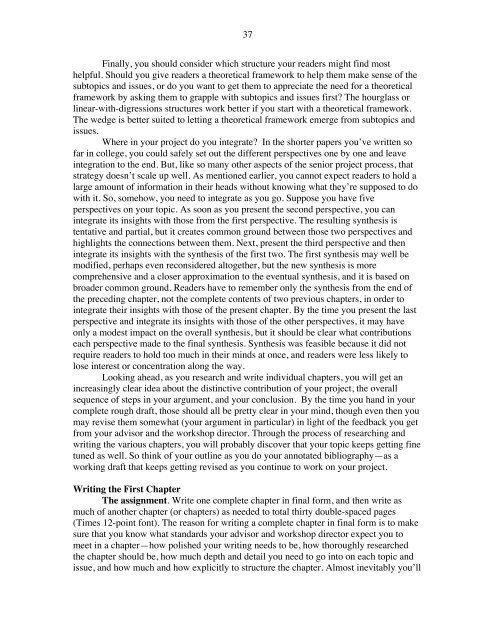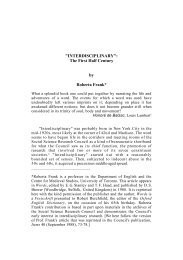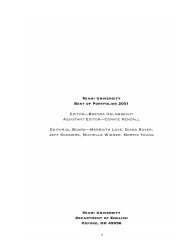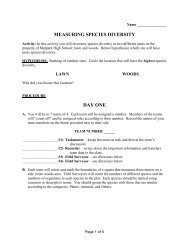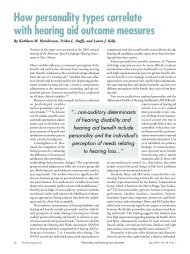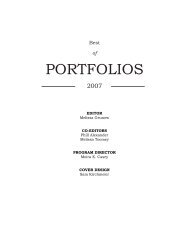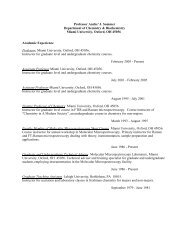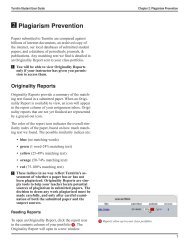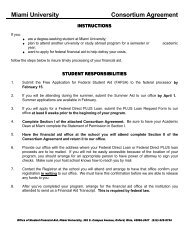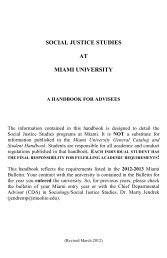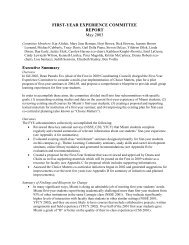Interdisciplinary Research Manual - Units.muohio.edu
Interdisciplinary Research Manual - Units.muohio.edu
Interdisciplinary Research Manual - Units.muohio.edu
You also want an ePaper? Increase the reach of your titles
YUMPU automatically turns print PDFs into web optimized ePapers that Google loves.
37<br />
Finally, you should consider which structure your readers might find most<br />
helpful. Should you give readers a theoretical framework to help them make sense of the<br />
subtopics and issues, or do you want to get them to appreciate the need for a theoretical<br />
framework by asking them to grapple with subtopics and issues first? The hourglass or<br />
linear-with-digressions structures work better if you start with a theoretical framework.<br />
The wedge is better suited to letting a theoretical framework emerge from subtopics and<br />
issues.<br />
Where in your project do you integrate? In the shorter papers you’ve written so<br />
far in college, you could safely set out the different perspectives one by one and leave<br />
integration to the end. But, like so many other aspects of the senior project process, that<br />
strategy doesn’t scale up well. As mentioned earlier, you cannot expect readers to hold a<br />
large amount of information in their heads without knowing what they’re supposed to do<br />
with it. So, somehow, you need to integrate as you go. Suppose you have five<br />
perspectives on your topic. As soon as you present the second perspective, you can<br />
integrate its insights with those from the first perspective. The resulting synthesis is<br />
tentative and partial, but it creates common ground between those two perspectives and<br />
highlights the connections between them. Next, present the third perspective and then<br />
integrate its insights with the synthesis of the first two. The first synthesis may well be<br />
modified, perhaps even reconsidered altogether, but the new synthesis is more<br />
comprehensive and a closer approximation to the eventual synthesis, and it is based on<br />
broader common ground. Readers have to remember only the synthesis from the end of<br />
the preceding chapter, not the complete contents of two previous chapters, in order to<br />
integrate their insights with those of the present chapter. By the time you present the last<br />
perspective and integrate its insights with those of the other perspectives, it may have<br />
only a modest impact on the overall synthesis, but it should be clear what contributions<br />
each perspective made to the final synthesis. Synthesis was feasible because it did not<br />
require readers to hold too much in their minds at once, and readers were less likely to<br />
lose interest or concentration along the way.<br />
Looking ahead, as you research and write individual chapters, you will get an<br />
increasingly clear idea about the distinctive contribution of your project, the overall<br />
sequence of steps in your argument, and your conclusion. By the time you hand in your<br />
complete rough draft, those should all be pretty clear in your mind, though even then you<br />
may revise them somewhat (your argument in particular) in light of the feedback you get<br />
from your advisor and the workshop director. Through the process of researching and<br />
writing the various chapters, you will probably discover that your topic keeps getting fine<br />
tuned as well. So think of your outline as you do your annotated bibliography—as a<br />
working draft that keeps getting revised as you continue to work on your project.<br />
Writing the First Chapter<br />
The assignment. Write one complete chapter in final form, and then write as<br />
much of another chapter (or chapters) as needed to total thirty double-spaced pages<br />
(Times 12-point font). The reason for writing a complete chapter in final form is to make<br />
sure that you know what standards your advisor and workshop director expect you to<br />
meet in a chapter—how polished your writing needs to be, how thoroughly researched<br />
the chapter should be, how much depth and detail you need to go into on each topic and<br />
issue, and how much and how explicitly to structure the chapter. Almost inevitably you’ll


